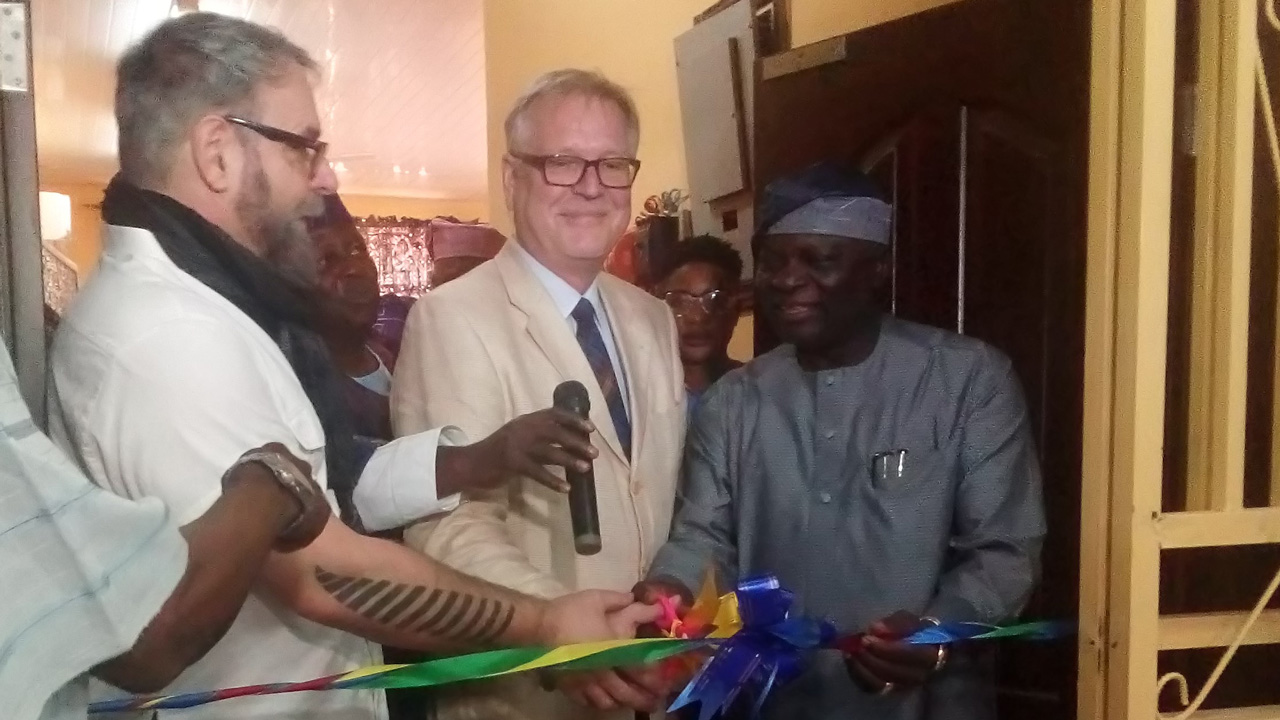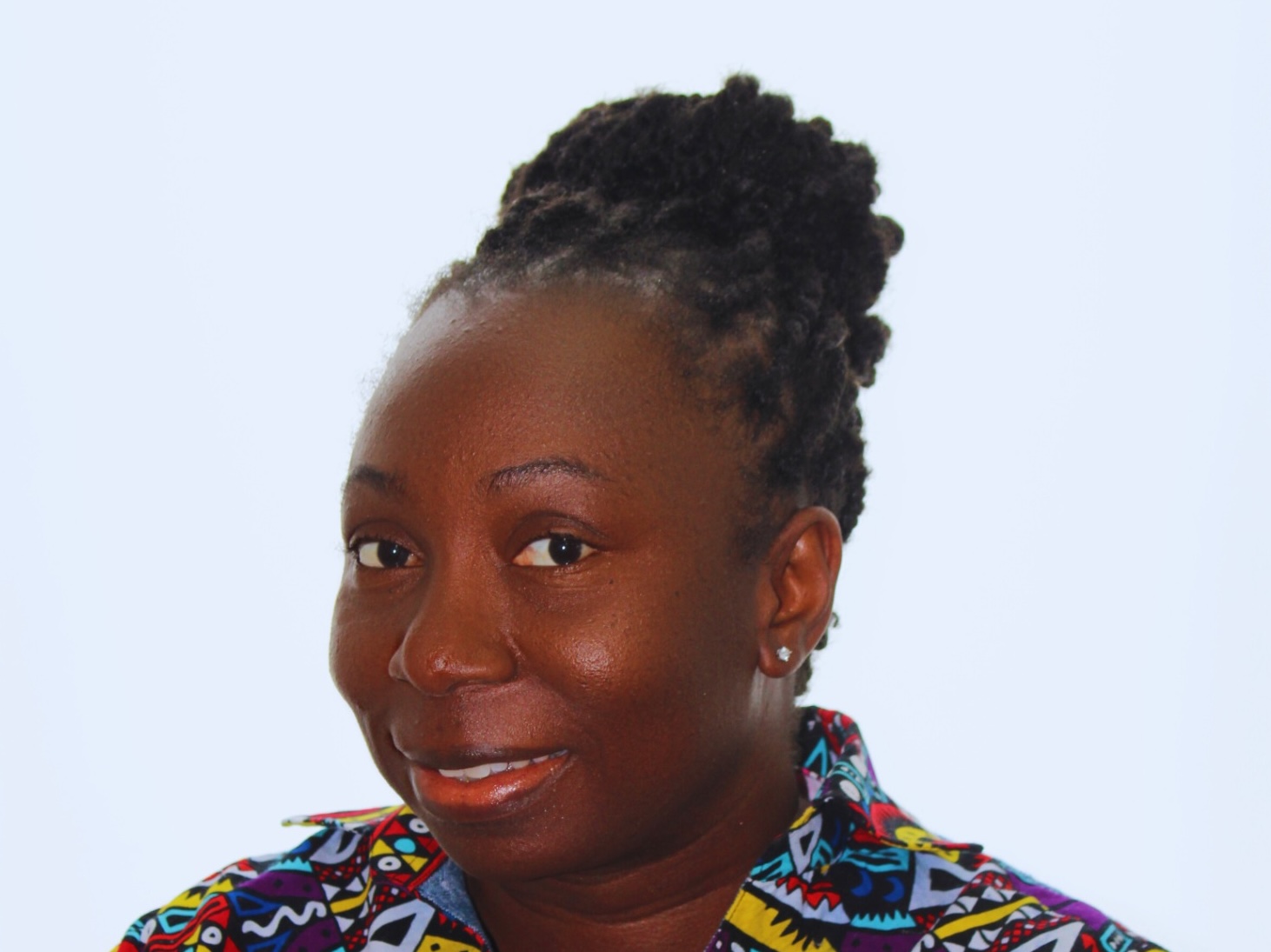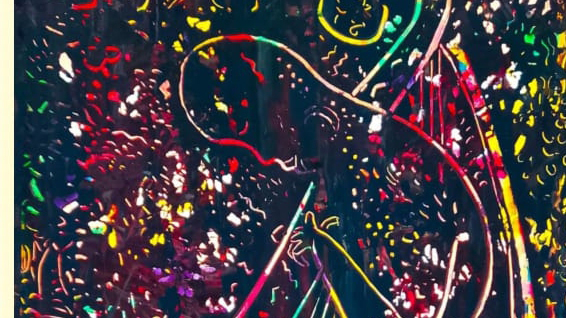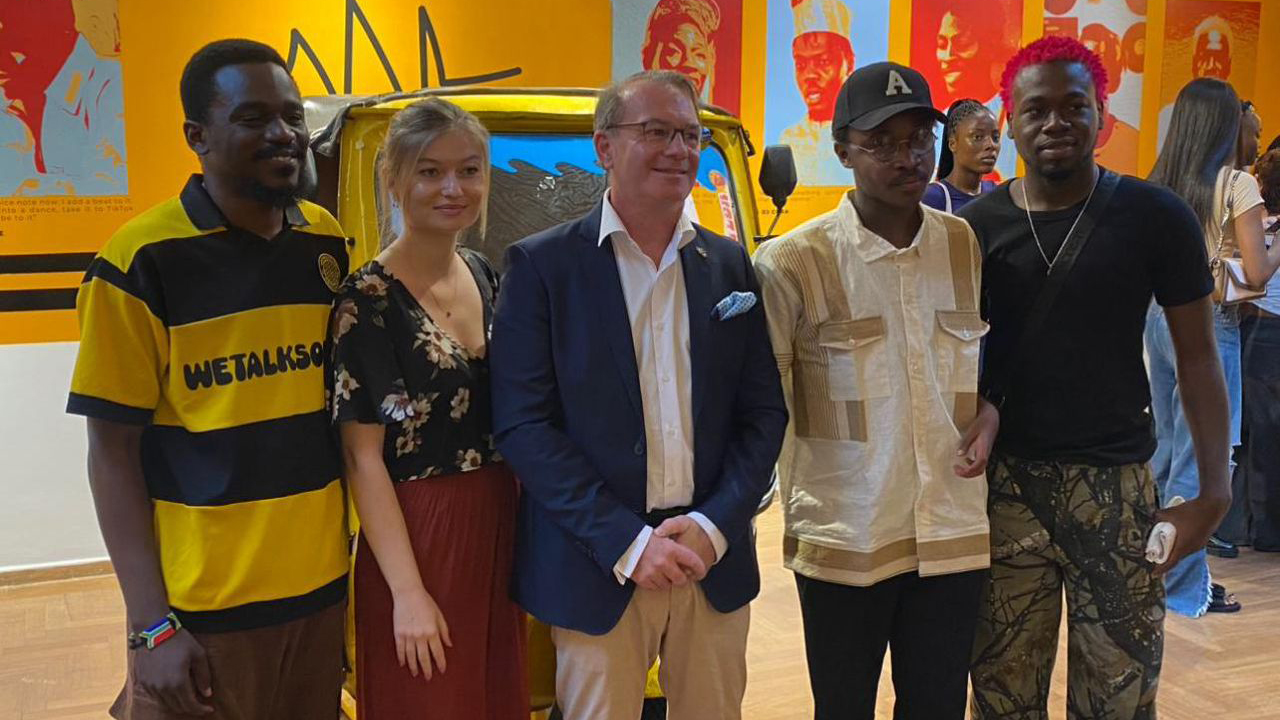
• CBCIU Marks 10, Celebrates Beier, Duro Ladipo
Recently, Osogbo, the capital of Osun State, was the cynosure of eyes, as culture missioners, art enthusiasts and collectors converged on the Centre for Black Culture and International (CBCIU) for the commissioning of Ulli Beier Archives, Duro Ladipo Museum and the unveiling of a book titled, Keeping Culture Alive: The Story Of The Centre For Black Culture And International written by Lasisi Olagunju, Akeem Lasisi and Kabir Alabi Garba.
The event attracted the Consul General, Embassy of Germany in Lagos, Dr. Stefan Traumann and his wife. It also had Director, Iwalewahaus, Dr. Ulf Vierke and curators from Iwalewahaus — Lena Naumann and Alexandra Kuhnke — make presentations. Katja Kellerer of Goethe Institut Nigeria was also around.
Commenting on CBCIU and the three events, Prince Olagunsoye Oyinlola, the former governor of Osun State and the Chair of CBCIU, disclosed that the three events marked the beginning of a steady growth and development for the centre.
The elated chairman revealed that his committee has, within a short time, achieved what the centre could not in the past six to seven years, adding that by the United Nations Educational, Scientific and Cultural Organisation (UNESCO) ratings, CBCIU is a repository of knowledge for black civilisation and to fully live up to this standard that a lot of work still need to be done to actualise its vision.
Dr. Traumann, speaking on the archival materials and the relationship that exists between Nigeria and Germany, said Ulli Beier was a true internationalist and that citizens of Nigeria and Germany should not forget Beier’s virtues, what he stood for and his achievements.
The envoy called on Nigerians and Germans to leverage on those things that make Beier and his wife outstanding , to develop stronger diplomatic relationship for the two countries and to live at peace.
The Consul General noted that global peace is very important and that countries can only achieve peace if the people understand their differences and respects each other’s cultures.
He said: “It is very important for Germany and Nigeria to embark on cultural exchange for the legacy of Beier has to be honoured and to make our friendship stronger. It is not only for the benefits of Germany, but for the whole of Europe because Beier was like an Ambassador to our continent and country.”
Describing the relationship that existed between Beier and Ladipo on one hand and CBCIU and the Iwalewahaus on the other, Emeritus Professor Michael Omolewa, Nigeria’s former Permanent Representatives to the UNESCO, who interacted with Ulli Beier while alive, said it was a union of cultures — Europe and Africa.
While noting that Beier was never satisfied doing one thing, Omolewa said he hated monotony and was always experimenting to bring out something new. According to Prof. Omolewa, when the University College, Ibadan was established on November 17, 1948, Ulli Beier was engaged to teach phonetics, but he turned down the offer, saying, “why would he teach the people to speak English like the English when the students will never meet the English people.”
He noted that Beier encouraged the people to be themselves and to speak Pidgin English; the very opposite thing he was recruited to do. The don noted that Beier refused to teach the students what the university authority wanted him to, so, his salary was stopped. “Even though he protested, the university authorities did not restore it, but denied him promotions instead.”
Omolewa disclosed that Beier was not satisfied with the situation, so that he left the university for Osogbo where he related well with the traditional rulers, including the Oba Moses Oyinlola and the Timi of Ede.
According to the historian, when Beier knew that the Timi of Ede could play the talking drum very well, he encouraged him to teach his people how to play the drum as well and this made the people of Ede to take special interest in drumming. He noted that Beier cultivated interest in traditional art.
Quoting Beier, the Prof, said: “Africans are being brainwashed to believe that everything western is a solution to their problems. Africans have in their hands — paintings, drawing, art and so on — that can be used to elevate their standard of living.”
The Prof. Emeritus revealed that it was the motivation Osogbo people got from Beier to lead a true African lifestyle that gave birth to the Osogbo Art Project.
Quoting Beier, he said: “An African has an attitude, a tradition and a world view; that Africa is a great nation, but the people look down on themselves and without the confidence to say they have arrived.”
Focusing on the Yoruba people, the don noted that Beier said the traditional Yoruba education system enables the people to train their own to behave properly like Omo lu abi (a perfect gentleman), who is good in language, skilled in productivity, never lazy, honest and a person of integrity.
Prof. Omolewa disclosed that Beier held the axiom that Iwa le wa (your value, attitude constitute the nobility, adding that he was a man that liked cross habilitation ventilation and cross-pollination of ideas.
Chief Jimoh Buraimoh, one of the notable Osogbo artists, disclosed that his connection with Beier started with Duro Ladipo Theatre, who engaged him in 1964, as an electrician, but meeting Beier, he shifted to painting and since then has not regretted his actions.
Buraimoh said Beier encouraged arts and was the brain behind Osogbo art. According to the artist, Beier and Ladipo were like twin brothers and were both involved in all aspect of arts, including theatre.
“Many of us never realised that we could work and present it for people to see and buy, but Beier changed our thinking and orientation of art. He made us to participate in different workshops within and outside the country to develop our skills. And today, we have painters, graphic artists, and textile printers among others. He taught us how to properly present our works for people to see and buy.”
Graphically showcasing the over 20,000 pictures taken by Beier while at Osogbo, the Director of Iwalewahaus, Dr. Vierke, said he has learnt a lot from the Yoruba culture and that the three-in-one event would further document current happenings in Osogbo for the future.
Vierke disclosed that Beier brought Yoruba culture to Bayreuth, adding that Iwalawehaus is a satellite of Osogbo Art Project, the CBICU and other partners from East Africa.
According to him, the institute has a lot of items about the Yoruba culture, stressing that it has hosted over 27,000 pictures taken by Ulli Bier in the past seven years.
Alexandra Kuhnke, one of the curators from Iwalewahaus, said the exhibition gives insights into the fragmented archive of Ulli and Georgina Beier. According to her, their excessive gathering and production of images is not only a testimony of their artistic and political agenda, but also a testimony of their personal search for a ‘new home,’ where they could live their fantasy and fulfil their desires.
She noted that Osogbo played a crucial role in this search, which they re-enacted later in Papua New Guinea, Australia and even in Germany. She disclosed that the two had a vast archive, not only in its material manifestations, but also as an organic construct, which evolved and changed through time due to encounters and experiences of the people involved. She noted that the images shown at the Ulli Beier Archive are fragments of the total images of the couple.
“The images we see here, today, in this archive have been selected to give a glimpse of the flashes of the consciousness or unconsciousness, personal narrations and information of Beier and his wife. And connected with other images, they reveal underlying networks of his person and emotion,” she said.
Speaking on his link with Beier, Oyinlola disclosed that he was just nine years old when his father passed away, adding that his family and others met Beier for his contributions to the book, which he did. He noted that it was from what he wrote about his late father, Oba Moses Oyewole Oyinlola, that the editors of the book extracted to give the book its title: Oba Moses Oyinlola Olokuku: Every Inch a King.
According to the former governor of Lagos and Osun states, the idea of having Beier’s archival materials housed in CBCIU in Osogbo where Beier called home, came at the book launch. He, however, added that Beier gave two conditions to be fulfilled for him to part with his materials.
According to the CBCIU Chair, the conditions are: that the Museum must be in Osogbo and secondly, the Chairman, which must be in perpetuity, must be Prince Oyinlola Olagunsoye.
He disclosed that the committee responsible for establishing CBCIU granted these two wishes of Beier and that was how it came to Osogbo and he became the chairman.
He called on all those that entertained fears that the said materials will end up in Obasanjo’s Library to have a rethink and come to CBCIU to see the over the 20,000 pictures in the Ulli Beier Archives and the Duro Ladipo Museum.
He noted that the book titled, Keeping Culture Alive: The Story of the Centre for Black Culture and International, unveiled to the public at the event was written to record the growth and development of CBCIU.
“We want to keep records, this is an institution that has the mission of documenting everything about the black man; so, as we grow, we must record our progress to measure how fast we are moving. It is on this ground that the book was written,” he said.
The Executive Director of CBICU, Prof Siyan Oyeweso disclosed that in all places Ulli Beier touched, the most significant to the centre is his relationship with the traditional rulers, adding that the culture icon was close to five traditional rulers — Oba Moses Oyinlola Olokunkun; Timi of Ede, Samuel Adenle; Adeyemi of Ikirun; the Ogaga of Ikere and the Ooni Adesoji Aderemi.
CBICU head disclosed that of all, the most significant is his relationship with Oba Moses Oyinlola Olokunkun, because whatever the centre has, it is to the great and exceptional individuals like him, who have left their marks on the sands of time.
Ladepo Duro-Ladipo, speaking on behalf of the Duro Ladipo family, said little did he know that CBICU recognised the contributions of his late father to Nigerian theatre and that the whole family is grateful to the people that supported his father to be what he was.
According to him, there is no way you discuss Duro Ladipo without the mention of Ulli Beier and Wole Soyinka, adding that this must have been the reason the organisers of the events combined the celebration of the 10-year anniversary of CBICU with the opening of the Ulli Beier Archives, Duro Ladipo Museum and the launch of a book.






